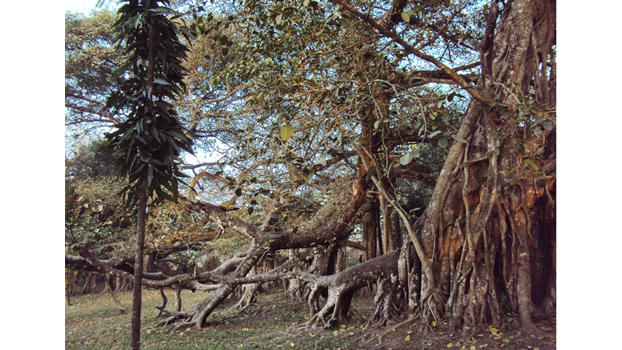3 century-old banyan tree on the verge of death for lack of care
It could be a source of earning from local, foreign tourists


For lack of care over the last couple of decades, the second largest banyan tree in Asia sub continent and largest in the country located at village Mallikpur of Kaliganj upazila in Jhenaidah is on the verge of death.
But it could be a source of earning huge revenue as the people of the country, as well as abroad come to visit this ancient tree in the remote village of Jhenaidah.
The inspection Bungalow (IB) constructed by the district council of Jhenaidah could not come in effect when the tree was not cared neither by the government nor by others. Now a local resident Abdul Khalek is taking care of the tree with his personnel efforts. Sometimes the drug addicts move there which hampers smooth movement of the people rush from far flung areas, especially, female, locals said.
Village Mallikpur is located about 9 kilometres south-east of Kaliganj town on Kaliganj-Khajura road, widely known as Suitala. The main plant was decayed long ago. Now the three-century old tree had expanded 45 branches occupying over two acres of land with a height for about 250 feet. Above 200 routes form the upper portion were deep-rooted in the earth for strengthening the branches.
The locals constructed boundary wall on 11 acres (33 bighas) of land on 1990 where Jhenaidah district council constructed a rest house at a cost of Taka 10 lakh near the huge giant tree. A number of concrete benches and garden umbrellas were set up to accommodate the visitors. Later Kunti Bibi, wife of some Jahur Ali of Mallikpur had donated her 32 decimals of land on in the name of the district council on April 25 in 1990.
A number of locals when contacted said Mallikpur Bazer was established in around Bengali year 1360 following the banyan tree when hundreds of visitors started moving to witness the tree. Initially the market was set at nearest Bethuli village. Later the market was shifted for a several times when the tree started expanding. Now about 56 various types of shops including hotel, restaurants were set up to serve the visitors and locals. Some of the businessmen had established pucca buildings.
Locals said the government stated looking after the tree when British Broadcasting Corporation (BC) had forecast a feature in 1982 stating it as the largest banyan tree in Asia. Since then the government had initiated preserving the tree.
Legends say there was a well, locally known as kua under the tree which was offering pure drinking water about 400 years back. Within a few decades the kua (well) was turned to a religious place for the people when they were being free from any diseases after drinking the water.
The Hindu community people started offering puja at a regular basis. As no one could fell any branch of the tree, it had expanded branches on surrounding areas that turned to a largest tree.
A section of people, under the umbrella of a political party had fell a number of large size branches and set under wrath through the saw mills. Some of the huge size wooden logs were also seized by the law enforcers, which deleted from the memory of the people. Yet the unruly people are not sitting idle.
When this correspondent was visiting the largest banyan tree, witnessed that huge garbage including polythene papers. Abdul Khalek, the voluntarily serving there for last 12 years said he had transplanted about 50 saplings of banyan at places in past years and nursing the same.
Ex chairman of local union parishad Shawkatul Islam when contacted said they had transplanted a number of saplings and flower while the banglo and parts of the tree went under the control of drug addicts. T he dishonest people had looted the iron grills and other parts of the inspection banglo as there is actually no body to care the same. They have also fell down a number of branches of the giant tree. The fate of the largest tree is uncertain, he apprehended.
Assistant conservator of forest (ACF) Mohammad Giasuddin when contacted said they could not deploy any guard or caretaker there as they it was under process. If a regular staff was provided at Mallipur, he could take the responsibility for nursing the trees and serve the visitors.



